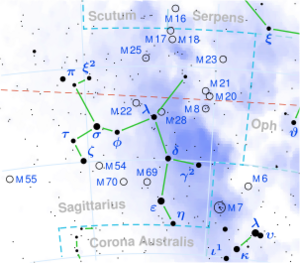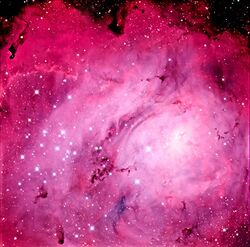Astronomy:9 Sagittarii
| Observation data Equinox J2000.0]] (ICRS) | |
|---|---|
| Constellation | Sagittarius |
| Right ascension | 18h 03m 52.44501s[1] |
| Declination | −24° 21′ 38.6323″[1] |
| Apparent magnitude (V) | 5.97[2] |
| Characteristics | |
| Spectral type | O4V((f))z[3] (O3.5V((f+)) + O5–5.5V((f))[4]) |
| U−B color index | −0.89[2] |
| B−V color index | 0.00[2] |
| Astrometry | |
| Radial velocity (Rv) | 10.70[5] km/s |
| Proper motion (μ) | RA: +0.539[1] mas/yr Dec.: −2.019[1] mas/yr |
| Parallax (π) | 0.8001 ± 0.0728[1] mas |
| Distance | 4,100 ± 400 ly (1,200 ± 100 pc) |
| Absolute magnitude (MV) | −6.20[4] |
| Orbit[6] | |
| Period (P) | 3,261±69 d |
| Semi-major axis (a) | 4,100 R☉[7] |
| Eccentricity (e) | 0.648±0.009 |
| Inclination (i) | 86.5±0.5° |
| Semi-amplitude (K1) (primary) | 36+4 −1 km/s |
| Semi-amplitude (K2) (secondary) | 49±3 km/s |
| Details[6] | |
| 9 Sgr A | |
| Mass | 32.1±16.0 M☉ |
| Radius | 10.8±1.0 R☉ |
| Luminosity | 479,000 L☉ |
| Surface gravity (log g) | 3.87±0.20 cgs |
| Temperature | 46,000±1,000 K |
| Rotational velocity (v sin i) | 102+8 −12 km/s |
| 9 Sgr B | |
| Mass | 18.9±10.1 M☉ |
| Radius | 8.9±1.2 R☉ |
| Luminosity | 224,000 L☉ |
| Surface gravity (log g) | 3.87±0.20 cgs |
| Temperature | 42,000±1,000 K |
| Rotational velocity (v sin i) | 67+6 −13 km/s |
| Age | ~1 Myr |
| Other designations | |
| Database references | |
| SIMBAD | data |
9 Sagittarii (9 Sgr) is a massive binary star in the constellation Sagittarius. It has an apparent magnitude of 5.97. Both components are highly luminous O-type main-sequence stars.
Surroundings
9 Sgr is a naked eye star lying in the direction of the Lagoon Nebula (Messier 8), very close to the central condensation of the Hourglass Nebula around Herschel 36. It was not catalogued by Bayer with a Greek letter, but was listed by Flamsteed as number 9 in the constellation Sagittarius. It lies close to the open cluster NGC 6530. 9 Sgr is the main source of ionisation for much of the visible nebulosity in the region, although the young O star Herschel 36 ionises the dense Hourglass Nebula region.[8]
9 Sgr itself is surrounded by an ionised HII region about 30 light years across including the reflection nebulae NGC 6523 and NGC 6533. This ionised region lies in front of a denser molecular cloud.[8]
The distances to 9 Sgr, M8, and NGC 6530 are uncertain, but generally estimated to be between 1,200 and 1,800 parsecs. Recent studies derive a distance around 1,250 pc for the M8 region.[8] Erosion of the front of the molecular cloud apparently caused by 9 Sgr suggests that it lies in front of the cloud, but studies of 9 Sgr as a binary star give a distance of 1,790 pc.[4][9] A 2021 study of the binary system derives a distance of 1,310±60 pc. On this basis, it is thought to be a member of the NGC 6530 open cluster.[6]
System
9 Sagittarii is a binary system with the longest known period for a pair of class O stars at 9.1 years. The orbit is eccentric and the separation between the stars varies from 11 AU to 27 AU. The large separation means that the stellar winds of the two stars do not impact strongly and so the pair are not a strong source of x-rays. Lack of x-rays, low orbital velocities, and similar spectral types merging to a combined spectrum of O4V, mean that 9 Sgr was only confirmed to be a binary in 2012.[4] Earlier clues such as nonthermal radio emission and periodic spectral line profile variations had prompted the detail search for a companion.[10][11]
The two stars have been resolved using the Hubble Space Telescope Fine Guidance Sensor and with ground-based interferometry using the Very Large Telescope PIONIER instrument.[12][13]
Properties
Both components of 9 Sgr are massive main sequence class O stars, and both have effective temperatures above 40,000 K. Each emits several hundred thousand times the luminosity of the Sun. At an age of about one million years, both are still main sequence stars fusing hydrogen in their cores, although strong convection have enriched the surface with nitrogen and helium which are visible in the spectrum. The powerful stellar winds produce emission lines in their spectra.[4]
References
- ↑ 1.0 1.1 1.2 1.3 1.4 Vallenari, A. et al. (2022). "Gaia Data Release 3. Summary of the content and survey properties". Astronomy & Astrophysics. doi:10.1051/0004-6361/202243940 Gaia DR3 record for this source at VizieR.
- ↑ 2.0 2.1 2.2 Ducati, J. R. (2002). "VizieR Online Data Catalog: Catalogue of Stellar Photometry in Johnson's 11-color system". CDS/ADC Collection of Electronic Catalogues 2237. Bibcode: 2002yCat.2237....0D.
- ↑ Sota, A.; Maíz Apellániz, J.; Morrell, N. I.; Barbá, R. H.; Walborn, N. R.; Gamen, R. C.; Arias, J. I.; Alfaro, E. J. (2014). "The Galactic O-Star Spectroscopic Survey (GOSSS). II. Bright Southern Stars". The Astrophysical Journal Supplement 211 (1): 10. doi:10.1088/0067-0049/211/1/10. Bibcode: 2014ApJS..211...10S.
- ↑ 4.0 4.1 4.2 4.3 4.4 Rauw, G.; Sana, H.; Spano, M.; Gosset, E.; Mahy, L.; De Becker, M.; Eenens, P. (2012). "9 Sagittarii: Uncovering an O-type spectroscopic binary with an 8.6 year period". Astronomy & Astrophysics 542: A95. doi:10.1051/0004-6361/201219254. Bibcode: 2012A&A...542A..95R.
- ↑ Gontcharov, G. A. (2006). "Pulkovo Compilation of Radial Velocities for 35 495 Hipparcos stars in a common system". Astronomy Letters 32 (11): 759–771. doi:10.1134/S1063773706110065. Bibcode: 2006AstL...32..759G.
- ↑ 6.0 6.1 6.2 Fabry, M.; Hawcroft, C.; Frost, A. J.; Mahy, L.; Marchant, P.; Le Bouquin, J. -B.; Sana, H. (2021). "Resolving the dynamical mass tension of the massive binary 9 Sagittarii". Astronomy and Astrophysics 651: A119. doi:10.1051/0004-6361/202140452. Bibcode: 2021A&A...651A.119F.
- ↑ Krtička, J.; Kubát, J.; Krtičková, I. (2015). "X-ray irradiation of the winds in binaries with massive components". Astronomy & Astrophysics 579: A111. doi:10.1051/0004-6361/201525637. Bibcode: 2015A&A...579A.111K.
- ↑ 8.0 8.1 8.2 Tothill, N. F. H.; Gagné, M.; Stecklum, B.; Kenworthy, M. A. (2008). "The Lagoon Nebula and its Vicinity". Handbook of Star Forming Regions: 533. Bibcode: 2008hsf2.book..533T.
- ↑ Kalari, V. M.; Vink, J. S.; Drew, J. E.; Barentsen, G.; Drake, J. J.; Eislöffel, J.; Martín, Eduardo L.; Parker, Q. A. et al. (2015). "Classical T Tauri stars with VPHAS+ - I. H α and u-band accretion rates in the Lagoon Nebula M8". Monthly Notices of the Royal Astronomical Society 453 (1): 1026–1046. doi:10.1093/mnras/stv1676. Bibcode: 2015MNRAS.453.1026K.
- ↑ Abbott, D. C.; Bieging, J. H.; Churchwell, E. (1984). "The detection of variable, nonthermal radio emission from two O type stars". Astrophysical Journal 280: 671. doi:10.1086/162040. Bibcode: 1984ApJ...280..671A.
- ↑ Rauw, G.; Blomme, R.; Waldron, W. L.; Corcoran, M. F.; Pittard, J. M.; Pollock, A. M. T.; Runacres, M. C.; Sana, H. et al. (2002). "A multi-wavelength investigation of the non-thermal radio emitting O-star 9 Sgr". Astronomy and Astrophysics 394 (3): 993. doi:10.1051/0004-6361:20020926. Bibcode: 2002A&A...394..993R.
- ↑ Aldoretta, E. J.; Caballero-Nieves, S. M.; Gies, D. R.; Nelan, E. P.; Wallace, D. J.; Hartkopf, W. I.; Henry, T. J.; Jao, W.-C. et al. (2015). "The Multiplicity of Massive Stars: A High Angular Resolution Survey with the Guidance Sensor". The Astronomical Journal 149 (1): 26. doi:10.1088/0004-6256/149/1/26. Bibcode: 2015AJ....149...26A.
- ↑ Sana, H.; Le Bouquin, J.-B.; Lacour, S.; Berger, J.-P.; Duvert, G.; Gauchet, L.; Norris, B.; Olofsson, J. et al. (2014). "Southern Massive Stars at High Angular Resolution: Observational Campaign and Companion Detection". The Astrophysical Journal Supplement Series 215 (1): 15. doi:10.1088/0067-0049/215/1/15. Bibcode: 2014ApJS..215...15S.
 |



